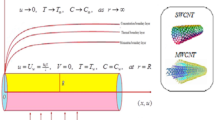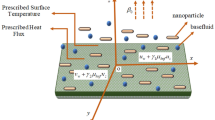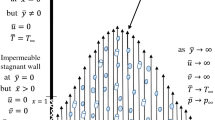Abstract
This article addresses velocity slip and induced magnetic field effects on heat transfer and nanofluid flow toward a curved stretching sheet. For a comprehensive and realistic analysis most commonly, used fluids such as water and propylene glycol are taken as the base fluids and single- and multi-wall carbon nanotubes (CNTs) are treated as the nanoparticles. Carbon nanotubes are considered due to their unusual characteristics like extraordinary thermal conductivity, viscosity, heat capacity, density, etc., which are significant in nanotechnology, electronics and material sciences. Moreover, heat transfer is discussed in the presence of heat generation and radiative heat flux. The curvilinear coordinates system has opted for mathematical formulation. The governing system of equations is simplified by employing similarity analysis. Computational analysis is performed on a reduced system by means of shooting method in computational software MATLAB. The computed distributions of velocity, induced magnetic field and temperature are examined for pertinent emerging parameters graphically. Furthermore, bar charts are drawn for the skin friction coefficient and Nusselt number. Some of the major findings include: velocity increased with an increase in surface bendiness. Moreover, the increase in velocity was reported to be slightly more in case of MWCNTs. Fluid flow decelerated with an increase in slip velocity. Reciprocal magnetic Prandtl number contributed to decelerating fluid flow. Moreover, magnetic parameter and \(\gamma \) played a significant role in increasing fluid velocity. The presence of CNTs contributed to accelerating fluid flow. Furthermore, the temperature was a decreasing function of surface bendiness. Moreover, the maximum temperature was observed in the case of SWCNTs–PG, while the minimum temperature was reported for MWCNTs–\({\text {H}}_2{\text {O}}\). Temperature rose for rising values of slip parameter. Reciprocal magnetic Prandtl number, heat generation parameter, thermal radiation and CNTs volumetric fraction contributed in up surging fluid temperature. Furthermore, the Nusselt number was an increasing function of \(\phi \), \(\beta \) and Rd, whereas the contrary results were noted for k, \(\kappa \) and N. Moreover, the maximum value of Nusselt number was reported for SWCNTs–\({\text {H}}_2{\text {O}}\). Also, skin friction increased for rising values of \(\phi \), whereas it decreased with an increase in k, \(\kappa \) and \(\beta \). Furthermore, maximum and minimum skin friction was noted for SWCNTs in case of both base fluids, respectively. The new-fangled results of the present investigation may be valuable in edifying research and in ceramic, plastic and polymer industry.
Similar content being viewed by others
Abbreviations
- \(f^{\prime }\) :
-
Dimensionless fluid velocity
- \(g^{\prime }\) :
-
Dimensionless induced magnetic field
- P :
-
Pressure
- Pr :
-
Prandtl number
- N :
-
Heat generation parameter
- Rd :
-
Radiation parameter
- k :
-
Curvature parameter
- u, v :
-
Longitudinal and transverse components of velocity
- \(H_1\), \(H_2\) :
-
Longitudinal and transverse induced magnetic field
- \(H_0 \) :
-
Upstream uniform magnetic field at infinity
- \(q_\mathrm{r} \) :
-
Radiative heat flux
- l :
-
Slip length
- \(k_\mathrm{nf} \) :
-
Thermal conductivity of nanofluid
- L :
-
Dimensional constant
- \(C_\mathrm{p} \) :
-
Specific heat
- \(Cf_\mathrm{s} \) :
-
Local skin friction coefficient
- \(Nu_\mathrm{s} \) :
-
Local Nusselt number
- \(Re_\mathrm{s} \) :
-
Local Reynolds number
- SWCNT:
-
Single-wall carbon nanotube
- MWCNT:
-
Multi-wall carbon nanotube
- PG\(\left( {{\text {C}}_3 {\text{ H }}_8 {\text{ O }}_2 } \right) \) :
-
Propylene glycol
- \({\text{ H }}_2 {\text{ O }}\) :
-
Hydrogen oxide (water)
- \(\eta \) :
-
Dimensionless space variable
- \(\theta \) :
-
Dimensionless temperature
- \(\lambda \) :
-
Reciprocal magnetic Prandtl number
- \(\beta \) :
-
Magnetic parameter
- \(\mu \) :
-
Dynamic viscosity
- \(\gamma \) :
-
Dimensionless parameter
- \(\sigma ^{*}\) :
-
Stefan–Boltzmann constant
- \(\phi \) :
-
Particle volume fraction
- \(\alpha \) :
-
Thermal diffusivity
- \(\nu \) :
-
Kinematic viscosity
- \(\rho \) :
-
Density
- \(\kappa \) :
-
Slip parameter
- w:
-
Wall condition
- \(\infty \) :
-
Condition at infinity
- nf, f, s:
-
Nanofluid, fluid, solid nanoparticles
- CNT:
-
Carbon nanotube
References
Choi, S.U.S.; Eastman, J.A.: Enhancing thermal conductivity of fluids with nanoparticles. In: The Proceedings of the 1995 ASME International Mechanical Engineering Congress and Exposition, ASME, San Francisco, USA, pp. 99–105. FED 231/MD 66 (1995)
Yu, W.; Choi, S.U.S.: The role of interfacial layers in the enhanced thermal conductivity of nanofluids: a renovated Maxwell model. J. Nanopart. Res. 5, 167–171 (2003)
Jang, S.P.; Choi, S.U.S.: Role of Brownian motion in the enhanced thermal conductivity of nanofluids. Appl. Phys. Lett. 84, 4316–4318 (2004)
Corcione, M.: Empirical correlating equations for predicting the effective thermal conductivity and dynamic viscosity of nanofluids. Energy Convers. Manag. 52, 789–793 (2011)
Masoumi, N.; Sohrabi, N.; Behzadmehr, A.: A new model for calculating the effective viscosity of nanofluids. J. Phys. D Appl. Phys. 42, 055501–055507 (2009)
Rehman, F.U.; Nadeem, S.: Heat transfer analysis for three-dimensional stagnation-point flow of water-based nanofluid over an exponentially stretching surface. J. Heat Transf. 140. (2018). HT-17-1037. https://doi.org/10.1115/1.4038359
Muhammad, N.; Nadeem, S.; Mustafa, M.T.: Impact of magnetic dipole on a thermally stratified ferrofluid past a stretchable surface. Proc. Inst. Mech. Eng. Part E J. Process Mech. Eng. 0, 1–7 (2018)
Abbas, N.; Saleem, S.; Nadeem, S.; Alderremy, A.A.; Khan, A.U.: On stagnation point flow of a micro polar nanofluid past a circular cylinder with velocity and thermal slip. Results Phys. 9, 1224–1239 (2018)
Rehman, F.U.; Nadeem, S.; Rehman, H.U.; Haq, R.U.: Thermophysical analysis for three-dimensional MHD stagnation-point flow of nano-material influenced by an exponential stretching surface. Results Phys. 8, 316–323 (2018)
Muhammad, N.; Nadeem, S.: Ferrite nanoparticles \(Ni\)-\(ZnFe_2 O_4 \), \(Mn\)-\(ZnFe_2 O_4 \) and \(Fe_2 O_4 \) in the flow of ferromagnetic nanofluid. Euro. Phys. J. Plus 132, 377–389 (2017)
Khan, W.A.; Pop, I.: Boundary layer flow of a nanofluid past a stretching sheet. Int. J. Heat Mass Transf. 53, 2477–2483 (2010)
Rehman, K.U.; Khan, A.A.; Malik, M.Y.; Makinde, O.D.: Thermophysical aspects of stagnation point magneto nanofluid flow yields by an inclined stretching cylindrical surface: a non-Newtonian fluid model. J Braz. Soc. Mech. Sci. Eng. 39, 3669–3682 (2017)
Maraj, E.N.; Iqbal, Z.; Shaiq, S.: Extraordinary role of hydrogen possessions and viscosity variation in electrically conducting copper and silver nanoparticles inspired by mixed convection. Int. J. Hydrog. Energy 43, 10915–10925 (2018)
Maraj, E.N.; Shaiq, S.; Iqbal, Z.: Assessment of hexahedron and lamina shaped graphene oxide nanoparticles suspended in ethylene and propylene glycol influenced by internal heat generation and thermal deposition. J. Mol. Liq. 262, 275–284 (2018)
Iqbal, Z.; Azhar, E.; Maraj, E.N.: Utilization of the computational technique to improve the thermophysical performance in the transportation of an electrically conducting \(Al_2 O_3\)–\(Ag/H_2 O\) hybrid nanofluid. Eur. Phys. J. Plus 132, 544–557 (2017)
Iqbal, Z.; Maraj, E.N.; Azhar, E.; Mehmood, Z.: A novel development of hybrid \(({\text{ MoS }}_2\)–\({\text{ SiO }}_2 /{\text{ H }}_2 {\text{ O }})\) nanofluidic curvilinear transport and consequences for effectiveness of shape factors. J. Taiwan Inst. Chem. Eng. 81, 150–158 (2017)
Mallikarjuna, B.; Rashad, A.M.; Chamkha, A.J.; Raju, S.H.: Chemical reaction effects on MHD convective heat and mass transfer flow past a rotating vertical cone embedded in a variable porosity regime. Afrika Matematika 27, 646–665 (2016)
EL-Kabeir, S.M.M.; Chamkha, A.J.; Rashad, A.M.: The effect of thermal radiation on non-Darcy free convection from a vertical cylinder embedded in a nanofluid porous media. J. Porous Media 17, 269–278 (2014)
Rashad, A.M.; Abbasbandy, S.; Chamkha, A.J.: Non-Darcy natural convection from a vertical cylinder embedded in a thermally stratified and nanofluid-saturated porous media. ASME J. Heat Transf. 136, 022503–022513 (2014)
Mallikarjuna, B.; Rashad, A.M.; Hussein, A.K.; Raju, S.H.: Transpiration and thermophoresis effects on non-Darcy convective flow past a rotating cone with thermal radiation. Arab. J. Sci. Eng. 41, 4691–4700 (2016)
Naveed, M.; Abbas, Z.; Sajid, M.: Nonlinear radiative heat transfer in Blasius and Sakiadis flows over a curved surface. Int. J. Thermophys. 38, 14–27 (2017)
Maraj, E.N.; Akbar, N.S.; Iqbal, Z.; Azhar, E.: Framing the MHD mixed convective performance of CNTs in rotating vertical channel inspired by thermal deposition: closed form solutions. J. Mol. Liq. 233, 334–343 (2017)
Rashad, A.M.: Impact of thermal radiation on MHD slip flow of a ferrofluid over a non-isothermal wedge. J. Magn. Magn. Mater. 422, 25–31 (2017)
Rashad, A.M.: Unsteady nanofluid flow over an inclined stretching surface with convective boundary condition and anisotropic slip impact. Int. J. Heat Technol. 35, 82–90 (2017)
Nadeem, S.; Ahmad, S.; Muhammad, N.: Computational study of Falkner–Skan problem for a static and moving wedge. Sens. Actuators B Chem. 263, 69–76 (2018)
Hayat, T.; Nadeem, S.: Flow of 3D Eyring–Powell fluid by utilizing Cattaneo–Christov heat flux model and chemical processes over an exponentially stretching surface. Results Phys. 8, 397–403 (2018)
Hayat, T.; Nadeem, S.: Aspects of developed heat and mass flux models on 3D flow of Eyring–Powell fluid. Results Phys. 7, 3910–3917 (2017)
Nadeem, S.; Ahmad, S.; Muhammad, N.: Cattaneo–Christov flux in the flow of a viscoelastic fluid in the presence of Newtonian heating. J. Mol. Liq. 237, 180–184 (2017)
Nadeem, S.; Ahmad, S.; Muhammad, N.; Mustafa, M.T.: Chemically reactive species in the flow of a Maxwell fluid. Results Phys. 7, 2607–2613 (2017)
Rehman, A.U.; Mehmood, R.; Nadeem, S.; Akbar, N.S.; Motsa, S.S.: Effects of single and multi-walled carbon nano tubes on water and engine oil based rotating fluids with internal heating. Adv. Powder Technol. 28, 1991–2002 (2017)
Hone, J.: Carbon nanotubes: thermal properties. Dekker Encycl. Nanosci. Nanotechnol. 603–610 (2004)
Ruoff, R.S.; Lorents, D.C.: Mechanical and thermal properties of carbon nanotubes. Carbon 33, 925–930 (1995)
Author information
Authors and Affiliations
Corresponding author
Rights and permissions
About this article
Cite this article
Shaiq, S., Maraj, E.N. Role of the Induced Magnetic Field on Dispersed CNTs in Propylene Glycol Transportation Toward a Curved Surface. Arab J Sci Eng 44, 7515–7528 (2019). https://doi.org/10.1007/s13369-019-03828-4
Received:
Accepted:
Published:
Issue Date:
DOI: https://doi.org/10.1007/s13369-019-03828-4




